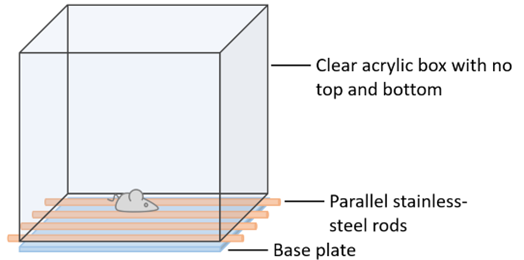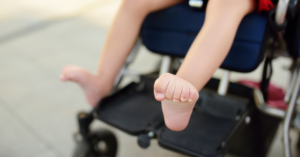
Disease-relevant research is often first conducted in animal models such as mice. This is done to investigate the underlying disease mechanisms and to test promising treatment strategies before moving into clinical studies.
The parallel rod floor test is an assay to measure motor coordination difficulties in mice. In the case of ataxia, the parallel rod floor test can validate the mouse models and test the effect of novel therapeutic approaches on motor incoordination in these models.
How does the parallel rod floor test work?
The testing apparatus consists of a clear acrylic box with parallel rods lined up at the bottom, with spacing in between. Underneath the rods is a baseplate that can measure when and where it is stepped on. Once a mouse is placed inside the box, it can move freely on the parallel rods. The number of times its paw slips through the rod is recorded through sensors in the baseplate, and the distance it has traveled in the box is tracked via a camera.

Figure 1: Schematic of the parallel rod floor test setup. Adapted from Kamens et al. 2007.
The test produces two independent parameters, the number of foot slips and the distance traveled. Both parameters are used in a ratio as a measure of motor incoordination. Mice with ataxia typically travel less distance and have more foot slips compared to wild-type mice. A therapeutic approach is therefore considered effective if it increases the distance traveled and reduces the number of foot slips.
Comparison to other tests
Many tests are available to measure ataxia in mice and examine slightly different parameters. Some, such as the rotarod assay, measure the ability of the mouse to retain balance on a rod and can also be used to measure motor learning.
Others, such as the random hole alley and paw slip test, measure the occurrence of the mouse’s paw slipping through gaps in the floor while exploring. These tests are affected by different factors such as visual function, anxiety levels, and motivation to explore, yielding different results. Therefore, multiple tests are often required to have a full understanding of the degree of ataxia.
The parallel rod floor test stems from the grid test (measuring foot slips in a chamber with wire mesh at the bottom) and the paw slip test (measuring foot slips in a chamber with parallel metal rods at the bottom). One major advantage of the test is that the measurement of incoordination takes into account the different activity levels of the mouse, a variable that may strongly affect the result otherwise. Variability in the experimental setup, such as the diameter and the spacing of the rods, also has minimal effect on the outcome of the test, which makes it more flexible in terms of experimental design. Limitations of the test include extreme results observed in some genetic models.
Motor coordination assays play a valuable role in accessing ataxia disease severity and have made significant contributions to establishing ataxia mouse models, understanding disease mechanisms, and identifying potential therapies. Ongoing research is working to improve the assays to lower variability and facilitate the transition into clinical studies.
If you would like to learn more about the parallel rod floor test, take a look at these resources by Nature Protocols.
Snapshot Written by: Christina (Yi) Peng
Edited by: Dr. Larissa Nitschke
References
Kamens, H. M. & Crabbe, J. C. The parallel rod floor test: a measure of ataxia in mice. Nat Protoc 2, 277–281 (2007).
Kamens, H. M., Phillips, T. J., Holstein, S. E. & Crabbe, J. C. Characterization of the parallel rod floor apparatus to test motor incoordination in mice. Genes, Brain and Behavior 4, 253–266 (2005).
Read Other SCAsource Snapshot Articles

Snapshot: What is Spasticity?
Spasticity is a condition where muscles involuntarily stiffen, impeding normal smooth movements. Spasticity can present in varying severities with varying impacts on daily life. For example, minor spasticity resulting in Read More…


Snapshot: What is Articulation?
Articulation refers to the ability to produce speech sounds using the tongue, lips, jaw, and the roof of your mouth. All of these organs are also known as articulators. The Read More…


Snapshot: What is Resonance?
In speech-language pathology, the term resonance refers to nasality in speech. In other words, how nasal a person’s speech sounds. When someone is congested, they likely sound hyponasal, or not Read More…









